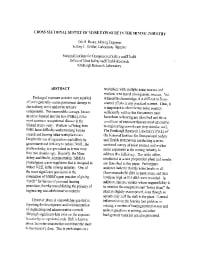Mining Publication: Cross-Sectional Survey of Noise Exposure in the Mining Industry
Original creation date: August 2000
Authors: ER Bauer, JL Kohler
NIOSHTIC2 Number: 20022771
Proc 31st Annual Institute of Mining Health, Safety and Research, Aug 27-30, 2000, Roanoke, VA, Bockosh-G, Karmis-M, Langton-J, McCarter-MK, Rowe-B, eds. Virginia Tech 2000 Aug; :17-30
Prolonged exposure to noise over a period of years generally causes permanent damage to the auditory nerve and/or its sensory components. This irreversible damage, known as noise-induced hearing loss (NIHL), is th most common occupational disease in the United States today. Workers suffering from NIHL have difficulty understanding human speech and hearing other workplace cues. Despite the use of regulations and efforts by government and industry to reduce NIHL, the problem today is as prevalent as it was more than two decades ago. Recently, the Mine Safety and Health Administration (MSHA) promulgated a new regulation that is designed to reduce NIHL in the mining industry. One of the more significant provisions is the elimination of MSHA's past practice of giving "credit" for the use of personal hearing protection, thereby reestablishing the primacy of engineering and administrative controls. However, there is a knowledge gap that is impeding the development and implementation of engineering and administrative controls. Although significant data exist on the exposure to noise by occupational code, little is known about the noise sources that contribute the most to the worker's dose. This is problematic in a workplace with multiple noise sources and workers who travel among noise sources. Yet without this knowledge, it is difficult to focus control efforts in any practical manner. Thus, it is important to characterize noise sources sufficiently well so that the sources most hazardous to hearing are identified and those conditions of exposure that are most amenable to engineering controls are pinpointed as well. The Pittsburgh Research Laboratory (PRL) of the National Institute for Occupational Safety and Health (NIOSH) is conducting a cross-sectional survey of noise sources and worker noise exposures in the mining industry to address this deficiency. The initial effort, conducted at a coal preparation plant and results are described in this paper. Preliminary analyses indicate that the noise levels on all floors exceeds 90 dBA in most areas, and that levels as high as 115 dBA were recorded. In addition, the one worker whose responsibility is to monitor the equipment and "house clean" the plant is slightly overexposed, even though he spends on half the shift in the plant. General information on the hearing loss problem in mining, a review of hearing protection used and noise regulations in mining, and other background materials are also presented.

NIOSHTIC2 Number: 20022771
Proc 31st Annual Institute of Mining Health, Safety and Research, Aug 27-30, 2000, Roanoke, VA, Bockosh-G, Karmis-M, Langton-J, McCarter-MK, Rowe-B, eds. Virginia Tech 2000 Aug; :17-30
- Administrative Controls for Reducing Worker Noise Exposures
- Determination of Sound Exposures (DOSES): Software Manual and Implementation Guide
- Noise and Hearing Protection: Development of Two Training Exercises for Drillers
- Noise Assessment of Stone/Aggregate Mines: Six Case Studies
- Noise Control in Underground Metal Mining
- Snapshot of Noise and Worker Exposures in Sand and Gravel Operations
- Sound Restoration Hearing Protection: Genesis of a Standard Test Method
- Technology News 536 - NIOSH Develops New Software to Analyze and Reduce Noise Exposure
- Water Well Safety Bits: Health And Safety Information For The Water Well Industry
- What Does a Hearing Loss Sound Like?